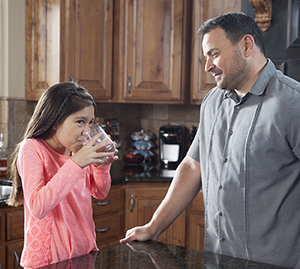After A Tonsillectomy or Adenoidectomy
Your child has had surgery to remove tonsils or adenoids. Your child will need time to get better. Below are guidelines to help your child recover.
Diet
Make sure your child gets enough fluids and healthy foods. Here are guidelines:
-
Give plenty of fluids. Good choices are water, frozen ice pops, and mild juices. Don't give orange juice or similar juices. Offer small amounts of fluids often. This will keep the area moist.
-
Give soft foods to eat. These include gelatin, pudding, and ice cream. Other choices are scrambled eggs, pasta, and mashed foods.
-
Don't give spicy, acidic, or rough foods. These include fresh fruits, toast, crackers, and potato chips.
Your child can eat as they normally would as long as it doesn't bother them.
 |
| Drinking plenty of fluids will help your child recover. |
Medicine for pain
Only give your child medicines that the healthcare provider has told you to give. This may include either ibuprofen or acetaminophen. In some cases, you may switch between these each time. Follow the healthcare provider’s directions closely. At first, you may be told to give your child medicine for pain even during the night. That means waking your child up at night to give them medicine. Check your child's pain at least every 4 hours.
When to call your child's healthcare provider
Mild pain and a slight fever are normal after surgery. The area where the surgery was done will turn whitish while it's healing. This is normal. It's not an infection. Call your child's healthcare provider right away if your child has any of these:
-
Fever that is high or doesn't go away (see Fever and children, below)
-
A seizure caused by the fever (See below for When tocall 911)
-
Severe pain not eased by medicine
-
Bright red bleeding from the nose or mouth, in spit, or in a clump (clot)
When to call 911
-
For any trouble breathing
-
If this is your child's first seizure
-
If the seizure lasts more than 5 minutes
-
If your child has back-to-back seizures or is not waking up after a seizure
-
If they were hurt during a seizure
Fever and children
Use a digital thermometer to check your child’s temperature. Don’t use a mercury thermometer. There are different kinds and uses of digital thermometers. They include:
-
Rectal. For children younger than 3 years, a rectal temperature is the most accurate.
-
Forehead (temporal). This works for children age 3 months and older. If a child under 3 months old has signs of illness, this can be used for a first pass. The provider may want to confirm with a rectal temperature.
-
Ear (tympanic). Ear temperatures are accurate after 6 months of age, but not before.
-
Armpit (axillary). This is the least reliable but may be used for a first pass to check a child of any age with signs of illness. The provider may want to confirm with a rectal temperature.
-
Mouth (oral). Don’t use a thermometer in your child’s mouth until they are at least 4 years old.
Use a rectal thermometer with care. Follow the product maker’s directions for correct use. Insert it gently. Label it and make sure it’s not used in the mouth. It may pass on germs from the stool. If you don’t feel OK using a rectal thermometer, ask the healthcare provider what type to use instead. When you talk with any healthcare provider about your child’s fever, tell them which type you used.
Below is when to call the healthcare provider if your child has a fever. Your child’s healthcare provider may give you different numbers. Follow their instructions.
When to call a healthcare provider about your child’s fever
For a baby under 3 months old:
-
First, ask your child’s healthcare provider how you should take the temperature.
-
Rectal or forehead: 100.4°F (38°C) or higher
-
Armpit: 99°F (37.2°C) or higher
-
A fever of ___________as advised by the provider
For a child age 3 months to 36 months (3 years):
-
Rectal or forehead: 102°F (38.9°C) or higher
-
Ear (only for use over age 6 months): 102°F (38.9°C) or higher
-
A fever of ___________ as advised by the provider
In these cases:
-
Armpit temperature of 103°F (39.4°C) or higher in a child of any age
-
Temperature of 104°F (40°C) or higher in a child of any age
-
A fever of ___________ as advised by the provider
Online Medical Reviewer:
Ashutosh Kacker MD
Online Medical Reviewer:
Marianne Fraser MSN RN
Online Medical Reviewer:
Melinda Murray Ratini DO
Date Last Reviewed:
7/1/2024
© 2000-2025 The StayWell Company, LLC. All rights reserved. This information is not intended as a substitute for professional medical care. Always follow your healthcare professional's instructions.